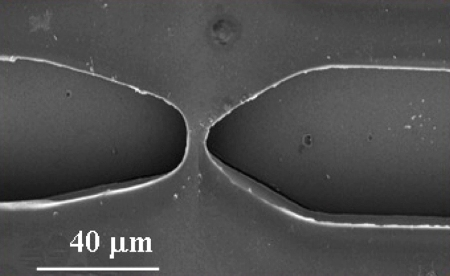Ohio State University scientists have developed an innovative method called nanochannel electroporation or NEP to deliver an accurate dosage of a gene therapy agent into a single living cell directly without the use of a needle.
 Two tiny reservoirs are connected by a nanometer-sized channel, which is too small to be seen at this magnification.Credit:Ohio State University
Two tiny reservoirs are connected by a nanometer-sized channel, which is too small to be seen at this magnification.Credit:Ohio State University
The novel method injects therapeutic biomolecules using electricity into a cell via a nanoscale channel within a fraction of second. The researchers, L. James Lee and his colleagues, have reported the method in the Nature Nanotechnology journal, in which they have described the delivery of an anti-cancer gene into single leukemia cells to destroy them.
According to Lee, NEP enables the researchers to study the impact of medicines and other biomolecules on genetic pathways and cell biology at an unprecedented level. In the method, a cell is suspended within an electronic device with a therapeutic agent reservoir nearby. The agent is pushed out of the tank due to electrical pulses and is passed via a nanoscale channel in the equipment, via the cell wall, and finally into the cell. By altering the channel’s width and the count of pulses, the research team is able to control the dosage of the gene agent.
The research team used polymer stamps to build prototype devices and gold-coated DNA strands as patterns for the nanoscale channels. The team stretched the strands between two reservoirs and performed etching to create a nano-channel having accurate dimensions linking the reservoirs inside the polymeric equipment.
Electrodes in the nano-channels make the equipment into a nano circuit and few hundred volts of electrical pulses along with the therapeutic agent shift from the first reservoir via the nano-channels into the equipment’s second reservoir, resulting in the generation of an intensified electric field at the opening of the nano-channel, which in turn creates a hole in the cell membrane by interacting with the electric charge of the cell. The hole is big enough to supply the agent, but insufficient to destroy the cell.
During the study of NEP for delivering active therapeutic agents into leukemia cells, the research team observed that longer electrical pulses of 10 ms destroyed most of the cells. Lee commented that the method is currently ideal for lab research, as it works on a single cell or quite a few cells at once. The research team is putting its efforts to devise a mechanical cell-loading system that can inject as many as 100,000 cells simultaneously, which could show the way to clinical treatments and diagnostics.
Source: http://www.osu.edu